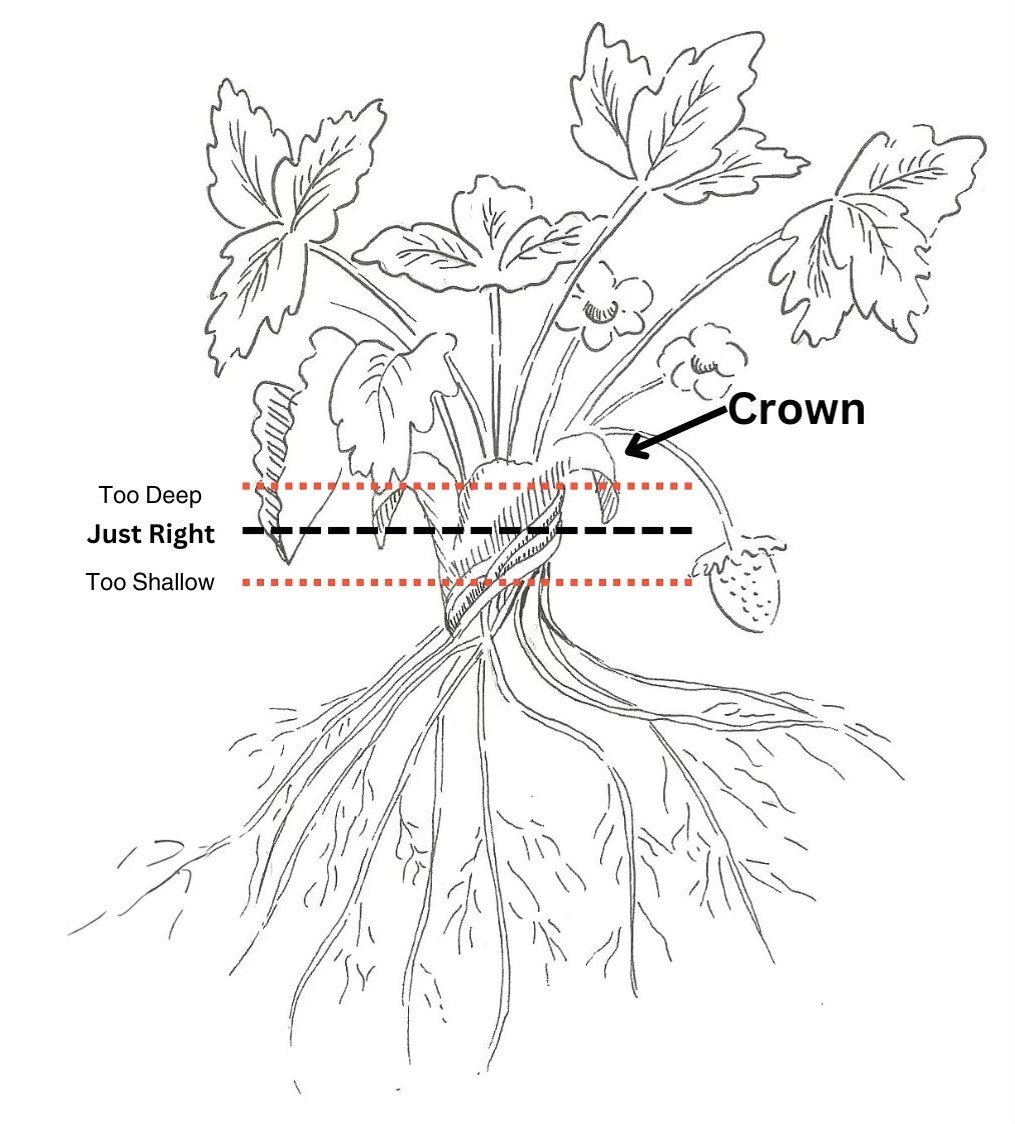Kent Strawberry Bare Root Planting Guide
Congratulations!
If you are reading this, you are the proud owner of some Kent Strawberry Bare Roots and are about to add them to your garden!
These roots have travelled from eastern Canada so they will need to be planted as soon as possible. You can make this task quick and easy on your self if you prepare your beds in advance.
Location - Choose an area with full sun. They require a minimum of 6 hours of sunshine daily but prefer 10+ hours. Plants grown in more sunlight will be more productive. Avoid areas where trees or buildings will cast shade over them. Do not plant in areas where herbicides have been used and in places where there is high perennial weed pressure.
Soil - Strawberries thrive in soil that is moist, well-drained soil, richly fertilized with compost or aged manure, and a slightly acidic pH. If you do not have well draining soil, raised beds are a good option. An initial application of 2” of aged compost can be worked into the beds before planting.
Straw or wood chip mulch can be added to your bed surface after your roots have been planted to help retain moisture and keep weed pressure down.
You may want to install drip irrigation or soaker hoses along your new beds under the mulch to make watering easy. This is the method I use and we have ours set on timers that automatically come on. They will need approximately 1-2” of moisture per week.
Avoid planting in beds that have recently had potatoes, tomatoes, peppers or eggplants in them to prevent Verticillium Wilt.
Timing - Plant roots as soon as you get them home. They are cold hardy and can be planted as soon as the soil can be worked. Do not wait until after last frost, a light frost or snow will not harm new plants.
If you are not able to plant them right away, store them in a cool dark place (the fridge will work) and do not allow the packing material around the roots to dry out or become soggy. All transplants prefer to be planted out in the cool parts of the day or on a cloudy day if possible.
Planting - Strawberry roots should always be set with their roots pointing downward in a fan shape. Set the plants deep enough so that the MID POINT of the crown is even with the soil surface. If the crown is too deep, they may rot and if its too far above the soil, it may dry out.
Space plants 12”-18” apart in rows that are 3’-4’ apart. The plants will produce runners with daughter plants. Allow 2-3 of these daughter plants per mother plant to establish themselves to fill in the gaps between plants. Allowing anymore than this will overcrowd your beds. Simply trim off any excess runners.
Maintenance - In the first year, pinch off any flowers so that the plants can put their energy into developing strong root systems. This will help to increase future productivity.
Water early in the day so that the plants have time to dry off before nightfall to help reduce the risk of leaf diseases.
In the fall after 2-3 frosts, cover plants with 4” of straw mulch to protect them over the winter. This mulch can be removed in the spring when growth begins and pulled into the pathways to help retain moisture and suppress weeds.
Overtime, thin the bed to maintain at least 6” inches between plants.
Strawberries are poor competitors so make sure to keep weeds out of your beds.
Lifespan - Because plants will become less productive over time, a strawberry planting may need to be replaced every 3-5 years.
Plant the crown so that the center of it is level with the ground.
Image courtesy of Sunflower & Swallow Gardens
Growing In Containers
Any strawberry can be grown in containers. Choose light coloured containers with good drainage. Mix potting soil with compost and add 3 plants to a 12” container or per square foot. Overcrowding will lead to poor production. Keep in mind that containers dry out quickly and will require extra attention to watering as they thrive in even moisture. This may mean watering multiple times a day but be careful not to let your plants get soggy as they do not handle excess moisture well. Remove any runners as they will take energy away from berry production.
Strawberries prefer cooler root temperatures and the roots of strawberries grown in pots will be warmer than those grown in the ground. To help mitigate this, choose light coloured pots and sprinkle some water on the pots when you water to help cool them down. You may want to choose a location that is sunny but not scorching to place your pots (not the south facing front of your house where it can get very warm).
When your container plants have finished fruiting, fertilize late summer with a 10-10-10 or organic equivalent at a rate of 1/3 oz per square foot. This application will help your plants set the buds that will become your flowers and berries next year.
Your containers will need additional winter protection as they do not have the ground to help insulate them. You may consider moving them into a cool garage in the winter or burying your pots in a pile of wood chips or straw until spring. If you bring them in, be sure that they don’t dry out completely. You may have to water them occasionally over the winter depending on the temperature in your garage.


